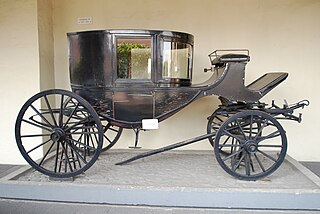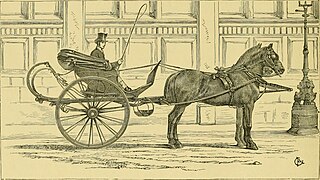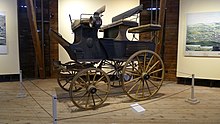
A stagecoach is a four-wheeled public transport coach used to carry paying passengers and light packages on journeys long enough to need a change of horses. It is strongly sprung and generally drawn by four horses although some versions are drawn by six horses.

A carriage is a two- or four-wheeled horse-drawn vehicle for passengers. In Europe they were a common mode of transport for the wealthy during the Roman Empire, and then again from around 1600 until they were replaced by the motor car around 1900. They were generally owned by the rich, but second-hand private carriages became common public transport, the equivalent of modern cars used as taxis. Carriage suspensions are by leather strapping or, on those made in recent centuries, steel springs. There are numerous names for different types. Two-wheeled carriages are usually owner-driven.

A wagon is a heavy four-wheeled vehicle pulled by draft animals or on occasion by humans, used for transporting goods, commodities, agricultural materials, supplies and sometimes people.

A buggy refers to a lightweight four-wheeled carriage drawn by a single horse, though occasionally by two. Amish buggies are still regularly in use on the roadways of America. The word "buggy" has become a generic term for "carriage" in America.

There are many types of car body styles. They vary depending on intended use, market position, location, and the era they were made.

Shooting-brake is a car body style which originated in the 1890s from horse-drawn carriage origins. The first automotive shooting brakes were manufactured in the early 1900s in the United Kingdom. The vehicle style became popular in England during the 1920s and 1930s, and was produced by vehicle manufacturers or as conversions by coachbuilders. The term was used in Britain interchangeably with "estate car" from the 1930s but has not been in general use for many years and has been more or less superseded by the latter term.

A phaeton was a form of sporty open carriage popular in the late eighteenth and early nineteenth century. Drawn by one or two horses, a phaeton typically featured a minimal very lightly sprung body atop four extravagantly large wheels. With open seating, it was both fast and dangerous, giving rise to its name, drawn from the mythical Phaëthon, son of Helios, who nearly set the Earth on fire while attempting to drive the chariot of the Sun.

A brougham is a 19th century four-wheeled carriage drawn by a single horse. It was named after the politician and jurist Lord Brougham, who had this type of carriage built to his specification by London coachbuilder Robinson & Cook in 1838.

A charabanc or "char-à-banc" is a type of horse-drawn vehicle or early motor coach, usually open-topped, common in Britain during the early part of the 20th century. It has "benched seats arranged in rows, looking forward, commonly used for large parties, whether as public conveyances or for excursions". It was especially popular for sight-seeing or "works outings" to the country or the seaside, organised by businesses once a year. The name derives from the French char à bancs, the vehicle having originated in France in the early 19th century.

A clarence is a type of carriage that was popular in the early 19th century. It is a closed, four-wheeled horse-drawn vehicle with a projecting glass front and seats for four passengers inside. The driver sat at the front, outside the carriage. The clarence was named after Prince William, Duke of Clarence and St Andrews, later King William IV of the United Kingdom, who died in 1837. It was introduced in 1840 in London. The Brougham was a lighter, two-passenger version originally commissioned by Lord Brougham.

A barouche is a large, open, four-wheeled carriage, both heavy and luxurious, drawn by two horses. It was fashionable throughout the 19th century. Its body provides seats for four passengers, two back-seat passengers vis-à-vis two behind the coachman's high box-seat. A leather roof can be raised to give back-seat passengers some protection from the weather.

A curricle is a light two-wheeled carriage drawn by two horses abreast. Usually open with a falling hood, it seats two people, plus a liveried groom on a seat or small platform between the rear springs—whose weight might be required to properly balance the carriage. Curricles are harnessed with a pole between the horses, and have an iron crossbar which rests over the harness saddle and supports the weight of the pole. The lightweight "swept" body is hung from a pair of outsized swan-neck cee-springs at the rear, with a minimal dashboard and a pair of lamps in front. For park driving, such as in the Bois de Boulogne or along the seafront at Honfleur, two liveried mounted grooms might follow.

A chaise, sometimes called shay, is a light two-wheeled carriage for one or two people. It may also have a folding hood. The coachmaker William Felton (1796) considered chaises a family of vehicles which included all two-wheel one-horse vehicles such as gigs and whiskies, whereas a similar carriage pulled by two-horses was considered a curricle.

A horse-drawn vehicle is a piece of equipment pulled by one or more horses. These vehicles typically have two or four wheels and were used to carry passengers or a load. They were once common worldwide, but they have mostly been replaced by automobiles and other forms of self-propelled transport but are still in use today.

A dogcart is a two-wheeled horse-drawn vehicle pulled by a single horse in shafts, or driven tandem. With seating for four, it was designed for sporting shooters and their gun dogs, with a louvred box under the driver's seat to contain dogs. It was developed in the early 1800s to afford more seating than the gig, which seats only two. Seating is two back-to-back crosswise seats, an arrangement called dos-à-dos from French. There is a hinged tailboard which lowers slightly and, supported by chains, acts as a footrest for the rear-facing passengers. Some dogcarts had a mechanism to slide the entire body forward or rearward along the shafts to help balance the weight for the horse.

A landau is a four-wheeled carriage with a cover that can be let down. It was a luxury carriage. The low shell of the landau provides maximal visibility of the occupants and their clothing, a feature that makes a landau a popular choice for ceremonial occasions.

A coach is a large, closed, four-wheeled, passenger-carrying vehicle or carriage usually drawn by two or more horses controlled by a coachman, a postilion, or both. A coach has doors in its sides and a front and a back seat inside. The driver has a raised seat in front of the carriage to allow better vision. It is often called a box, box seat, or coach box. There are many types of coaches depending on the vehicle's purpose.

A droshky or drosky is a term used for a four-wheeled open carriage used especially in Russia. The vehicle has a long bench on which the driver or passengers sit as if on a saddle, either astride or sideways. From droga, the pole that connects the front and rear axles.

A horse-bus or horse-drawn omnibus was a large, enclosed, and sprung horse-drawn vehicle used for passenger transport before the introduction of motor vehicles. It was mainly used in the late 19th century in both the United States and Europe, and was one of the most common means of transportation in cities. In a typical arrangement, two wooden benches along the sides of the passenger cabin held several sitting passengers facing each other. The driver sat on a separate, front-facing bench, typically in an elevated position outside the passengers' enclosed cabin. In the main age of horse buses, many of them were double-decker buses. On the upper deck, which was uncovered, the longitudinal benches were arranged back to back.

A wagonette or waggonette, meaning little wagon, is a four-wheeled open carriage drawn by one or two horses. It has a front seat for the driver, and passengers enter from the rear and sit face to face on longitudinal bench seats. Originating around the 1840s, the body is mounted on four sets of springs.
























